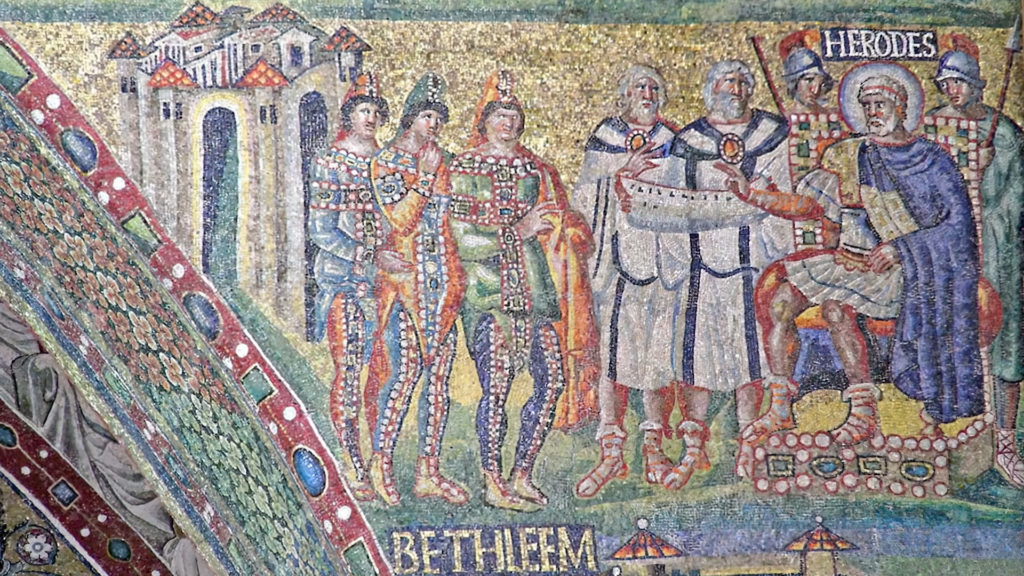
Herod the Great, who was the King of Judea during the Roman Empire, is said to have preserved the body of his deceased wife in honey for seven years, despite having ordered her execution.
That was at the end of a full life teetering between greatness and disgrace, honor and shame. It was definitely a life full of contradictions and controversy, as was fit for a king living in the tumultuous decades when the Romans had taken over Judea and Jesus Christ had been born.
The first biographer of Herod was the first century AD Jewish historian Flavius Josephus (born as Yosef ben Matityahu), who undertook the task to write the story of a man who was next to impossible to describe.
Herod and the Massacre of the Innocents
Herod’s name is embedded in collective memory with the Christmas story of the evil king who ordered the slaughter of all children under two years old near Bethlehem upon hearing that the King of the Jews had just being born. Immediately, Herod sent the three Magi to Bethlehem to locate the newborn.
The three wise men followed the Star of Bethlehem and found the infant with Joseph and Mary. They presented him with their gifts. Before they left to return to Herod, they had a dream about the king’s intention to send people to kill the baby. Hence, they never returned to Herod and went back to their homes using an alternative route.
Overcome by rage, Herod ordered that all male infants of Bethlehem under the age of two be slaughtered so that his kingdom would not be threatened by the new king. His order was executed, but Mary and Joseph had already been warned. They took baby Jesus and fled to Egypt.
However, the Massacre of the Innocents, as the atrocious act of Herod has been called, is only mentioned in the Gospel of Matthew. No other gospel or historical account mentions such an incident surrounding the birth of Christ. The majority of historians and biblical scholars consider this story to have been fabricated.
Who was Herod?
Herod I was born in 72 BC, at a time when Judea was an independent state, following the rebellion of the Maccabees who kicked out the Seleucid ruler Antiochus IV in 164 BC.
His father was Antipater, an Idumean from south of Judea, who had converted to Judaism, and his mother was the Arab princess, Cypros, from Nabatea. Herod was thus only half-Jewish to start with.
However, his father had good relations with Roman dictator Julius Caesar who entrusted Antipater with the public affairs of Judea. He, in turn, appointed Herod governor of Galilee in 47 BC. The young man earned the favor of Mark Antony and was named tetrarch in 41 BC.
A year later, the Parthians invaded Palestine, and civil war broke out. Antigonus took the throne with the help of the Parthians, and Herod was forced to flee to Rome.
In an unexpected turn, the Roman senate nominated him king of Judea and equipped him with an army to go back and claim the throne. In 37 BC, Herod became the unchallenged king of Judea. To solidify his power, he divorced his first wife, Doris, sent her and his son away from court, and married Mariamne, a Hasmonean princess.
Although the marriage was with the intent to end his feud with the Hasmonean dynasty, Herod was deeply in love with Mariamne.
Herod’s reign
As a ruler, Herod was good to his subjects. He implemented a program of grain importation from Egypt and thus helped counter the effects of drought, famine, and epidemics. He also lowered taxes for his citizens.
Furthermore, he was also very successful in infrastructure works. He built his own palace in Jerusalem and named it Antonia, in honor of his patron Mark Antony. He opened the strategic fortress called the Herodian, guarding the southern approaches to Jerusalem.
In 23 BC, he built the magnificent port city of Caesarea Maritima, a modern Mediterranean port that established Judea as a major economic force. His most famous building was the expansion of the Temple of Jerusalem, a grandiose project that glorified the Jewish religion. He also financially supported the Olympic Games.
Rome rewarded Herod’s successes by adding the northern and eastern regions of Trachonitis, Batanaea, and Auranitis to his rule.
Yet, some historians picture Herod as a cruel tyrant who introduced a type of police state of spies who punished by imprisonment, torture, and execution of anyone under the slightest suspicion.
Herod’s cruelty and ruthlessness were not limited to his subjects. During his reign, he did not hesitate to kill several close family members, including three of his sons, his Hasmonean beloved wife Mariamne, and his wife’s mother and grandfather.
Several scholars have focused on his ruthless character, his maniacal behavior, and personality disorders that marked his life and culminated in his painful disease, unsuccessful suicide attempts, and death.
The shocking final chapter
The most shocking detail of Herod’s tempestuous life is the aftermath of his wife’s execution, ordered by Herod himself, and the story of preserving her body in honey for seven years with the insinuation of necrophilia.
The last chapter of the tragic story of Mariamne and Herod’s obsession with her can be found in the Babylonian Talmud, the central text of Rabbinic Judaism:
He preserved her body in honey for seven years. Some say that he had [sexual] intercourse with her, others that he did not. According to those who say that he had intercourse with her, his reason for embalming her was to gratify his desires. According to those who say that he did not have intercourse with her, his reason was that people might say that he had married a king’s daughter.
See all the latest news from Greece and the world at Greekreporter.com. Contact our newsroom to report an update or send your story, photos and videos. Follow GR on Google News and subscribe here to our daily email!



